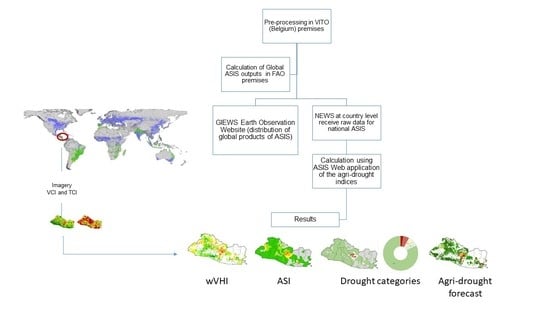Next Generation Agricultural Stress Index System (ASIS) for Agricultural Drought Monitoring
Abstract
:1. Introduction
2. Materials and Methods
2.1. Data
2.1.1. Global Earth Observation Data Sets
2.1.2. Ancillary Data
2.1.3. Study Cases
2.2. Methodology
2.2.1. National Calibration of ASIS
- VCI = Vegetation Condition Index;
- TCI = Temperature Condition Index;
- a = weight, in some studies different weights are assigned to VCI and TCI [23].
2.2.2. Weighted Vegetation Health Index (wVHI)
- wVHI = Weighted vegetation health index cumulated from SOS up to EOS multiplied by crop coefficient;
- VHI = Anomaly of VHI by dekad;
- kc = Crop coefficient.
2.2.3. Agricultural Stress Index (ASI)
2.2.4. Agricultural Drought Categories
2.2.5. Historical Drought Probabilities
2.2.6. Agricultural Drought Forecast
2.2.7. ASIS Web and GIS Applications
2.2.8. Derived Metrics from ASI
3. Results and Discussion
3.1. Rasterized Phenology and Crop Coefficients (kc)
3.2. Weighted Vegetation Health Index (wVHI) and Drought Impact within the Administrative Unit
3.3. Agricultural Stress Index (ASI), Crop Insurance and Social Protection Schemes
3.4. Agricultural Drought Categories, Early Action and National Drought Plans
3.5. Historical Drought Probabilities
3.6. Agricultural Drought Forecast and Early Action
3.7. ASIS Web and GIS Applications
3.8. Derived Metrics from ASI
4. Conclusions
Funding
Institutional Review Board Statement
Informed Consent Statement
Acknowledgments
Conflicts of Interest
References
- FAO. The Impact of Natural Hazards and Disasters on Agriculture and Food Security and Nutrition. A Call for Action to Build Resilient Livelihoods; FAO: Rome, Italy, 2015; 16p, Available online: https://reliefweb.int/sites/reliefweb.int/files/resources/a-i4434e_0.pdf (accessed on 24 October 2020).
- FAO. 2017 The Impact of Disasters and Crises on Agriculture and Food Security; FAO: Rome, Italy, 2018; 143p. [Google Scholar]
- Sivakumar, M.; Stefanski, R.; Bazza, M.; Zelaya, S.; Wilhite, D.; Rocha, A. High Level Meeting on National Drought Policy: Summary and Major Outcomes. Weather Clim. Extremes 2014, 3, 126–132. [Google Scholar] [CrossRef] [Green Version]
- Wilhite, D.A.; Pulwarty, R.S. Drought and water crises: Lessons learned and the road ahead. In Drought and Water Crises: Science, Technology, and Management Issues; Wilhite, D.A., Ed.; CRC Press: Boca Raton, FL, USA, 2005; Chapter 15; pp. 389–398. [Google Scholar]
- Wilhite, D.A.; Sivakumar, M.; Pulwarty, R.S. Managing drought risk in a changing climate: The role of national drought policy. Weather Clim. Extremes 2014, 3, 4–13. [Google Scholar] [CrossRef] [Green Version]
- Balzter, H. Earth Observation for Land and Emergency Monitoring; National Centre for Earth Observation, University of Leicester, Centre for Landscape and Climate Research, Department of Geography: Leicester, UK; Wiley: Hoboken, NJ, USA, 2017; 336p. [Google Scholar]
- Ge, T.; Sui, F.; Bai, L.; Tong, C. Effects of water stress on growth, biomass partitioning, and water-use efficiency in summer maize (Zea mays L.) throughout the growth cycle. Acta Physiol. Plant 2012, 34, 1043–1053. [Google Scholar] [CrossRef]
- Song, L.; Jin, J.; He, J. Effects of Severe Water Stress on Maize Growth Processes in the Field. Sustainability 2019, 11, 5086. [Google Scholar] [CrossRef] [Green Version]
- Gommes, R. FAOINDEX, Version 2.1; Agrometeorology Group FAO: Rome, Italy, 1993. [Google Scholar]
- Rojas, O.; Rembold, F.; Royer, A.; Negre, T. Real-time agrometeorological crop yield monitoring in Eastern Africa. Agron. Sustain. Dev. 2005, 25, 63–77. [Google Scholar] [CrossRef]
- Rojas, O.; Vrieling, A.; Rembold, F. Assessing drought probability for agricultural areas in Africa with coarse resolution remote sensing imagery. Remote Sens. Environ. 2011, 115, 343–352. [Google Scholar] [CrossRef]
- Van Hoolst, R.; Eerens, H.; Haesen, D.; Royer, A.; Bydekerke, L.; Rojas, O.; Li, Y.; Racionzer, P. FAO’s AVHRR-based Agricultural Stress Index System (ASIS) for global drought monitoring. Int. J. Remote Sens. 2016, 37, 418–439. [Google Scholar] [CrossRef]
- Rojas, O. Protocol for Country-Level ASIS Calibration and National Adaptation; FAO: Rome, Italy, 2015; pp. 12p. Available online: http://www.fao.org/3/a-i5246e.pdf (accessed on 15 November 2020).
- FAO. Country Level ASIS: A Drought Monitoring System; FAO: Rome, Italy, 2018; 8p, Available online: http://www.fao.org/3/CA0986EN/ca0986en.pdf (accessed on 20 November 2020).
- Eerens, H.; Baruth, B.; Bydekerke, L.; Deronde, B.; Dries, J.; Goor, E.; Heyns, W.; Jacobs, T.; Ooms, B.; Piccard, I.; et al. Ten-Daily Global Composites of METOP-AVHRR. In Proceedings of the 6th International Symposium on Digital Earth, Beijing, China, 9–12 September 2009. International Society for Digital Earth (ISDE). [Google Scholar] [CrossRef]
- Eerens, H.; Haesen, D.; Rembold, F.; Urbano, F.; Tote, C.; Bydekerke, L. Image Time Series Processing for Agriculture Monitoring. Environ. Model. Softw. 2014, 53, 154–162. [Google Scholar] [CrossRef]
- Doorenbos, J.; Kassam, A. Yield Response to Water; FAO Irrigation and Drainage Paper No. 33; FAO: Rome, Italy, 1979. [Google Scholar]
- Rouse, J.W., Jr.; Haas, R.H.; Schell, J.A.; Deering, D.W. Monitoring vegetation systems in the Great Plains with ERTS. In Third ERTS-1 Symposium; NASA, SP-351, Paper A 20; NASA: Washington, DC, USA, 1974; Volume 1, pp. 309–317. [Google Scholar]
- Kogan, F.N. Application of vegetation index and brightness temperature for drought detection. Adv. Space Res. 1995, 15, 91–100. [Google Scholar] [CrossRef]
- Kogan, F.; Yang, B.; Wei, G.; Zhiyuan, P.; Xianfeng, J. Modelling corn production in China using AVHRR-based vegetation health indices. Int. J. Remote Sens. 2005, 26, 2325–2336. [Google Scholar] [CrossRef]
- Vrieling, A.; de Beurs, K.M.; Brown, M.E. Recent trends in agricultural production of Africa based on AVHRR NDVI time series. In Proceedings of the SPIE Remote Sensing, Cardiff, Wales, UK, 2 October 2008. [Google Scholar] [CrossRef]
- Kogan, F. Global Drought Watch from Space. Bull. Am. Meteorol. Soc. 1997, 78, 621–636. [Google Scholar] [CrossRef]
- Unganai, L.; Kogan, F. Drought monitoring and corn yield estimation in Southern Africa from AVHRR data. Remote Sens. Environ. 1998, 63, 219–232. [Google Scholar] [CrossRef]
- Karnieli, A.; Agam, N.; Pinker, R.; Anderson, M.; Imhoff, M.; Gutman, G.; Panov, N.; Goldberg, A. NDVI and Land Surface Temperature for Drought Assessment: Merits and Limitations. J. Clim. 2010, 23, 618–633. [Google Scholar] [CrossRef]
- Singh, R.P.; Roy, S.; Kogan, F.N. Vegetation and temperature condition indices from NOAA–AVHRR data for drought monitoring over India. Int. J. Remote Sens. 2003, 24, 4393–4402. [Google Scholar] [CrossRef]
- Allen, R. Crop coefficients. In Encyclopaedia of Water Sciences; Marcel Dekker: New York, NY, USA, 2003. [Google Scholar] [CrossRef]
- Kogan, F.N. World droughts in the new millennium from AVHRR-based Vegetation Health Indices. EOS Trans. Am. Geophy. Union 2002, 83, 562–563. [Google Scholar] [CrossRef]
- Bhuiyan, C.; Singh, R.P.; Kogan, F. Monitoring drought dynamics in the Aravalli region (India) using different indices based on ground and remote sensing data. Int. J. Appl. Earth Observ. Geoinform. 2006, 8, 289–302. [Google Scholar] [CrossRef]
- Meroni, M.; Fasbender, D.; Kayitakire, F.; Pini, G.; Rembold, F.; Urbano, F.; Verstraete, M. Early detection of production deficit hot-spots in semi-arid environment using FAPAR time series and a probabilistic approach. Remote Sens. Environ. 2014, 142, 57–68. [Google Scholar] [CrossRef]
- Fuganti, G.; Minelli, M.; Rojas, O. Practical Guidelines for Early Warning Early Action Plans on Agricultural Drought; FAO: Panama City, FL, USA, 2020; Available online: http://www.fao.org/3/cb0624es/cb0624es.pdf (accessed on 4 December 2020).
- Philippine Statistics Authority (PSA). Consumption of Agricultural Commodities in the Philippines; PSA: Quezon City, Philippines, 2017; Volume 1. Available online: https://psa.gov.ph/sites/default/files/2015-2016%20CSAC%20Vol1.pdf (accessed on 10 July 2019).
- Statista. 2019. Available online: https://www.statista.com/statistics/255971/top-countries-based-on-rice-consumption-2012-2013/ (accessed on 20 September 2020).
- Cocheme, J.; Franquin, P. Etude Agroclimatologique Dans une zone Semi-aride en Afrique au sud du Sahara Projet Conjoint; FAO; UNESCO; OMMFAO: Rome, Italy, 1967; Volume VIII, 326p. [Google Scholar]


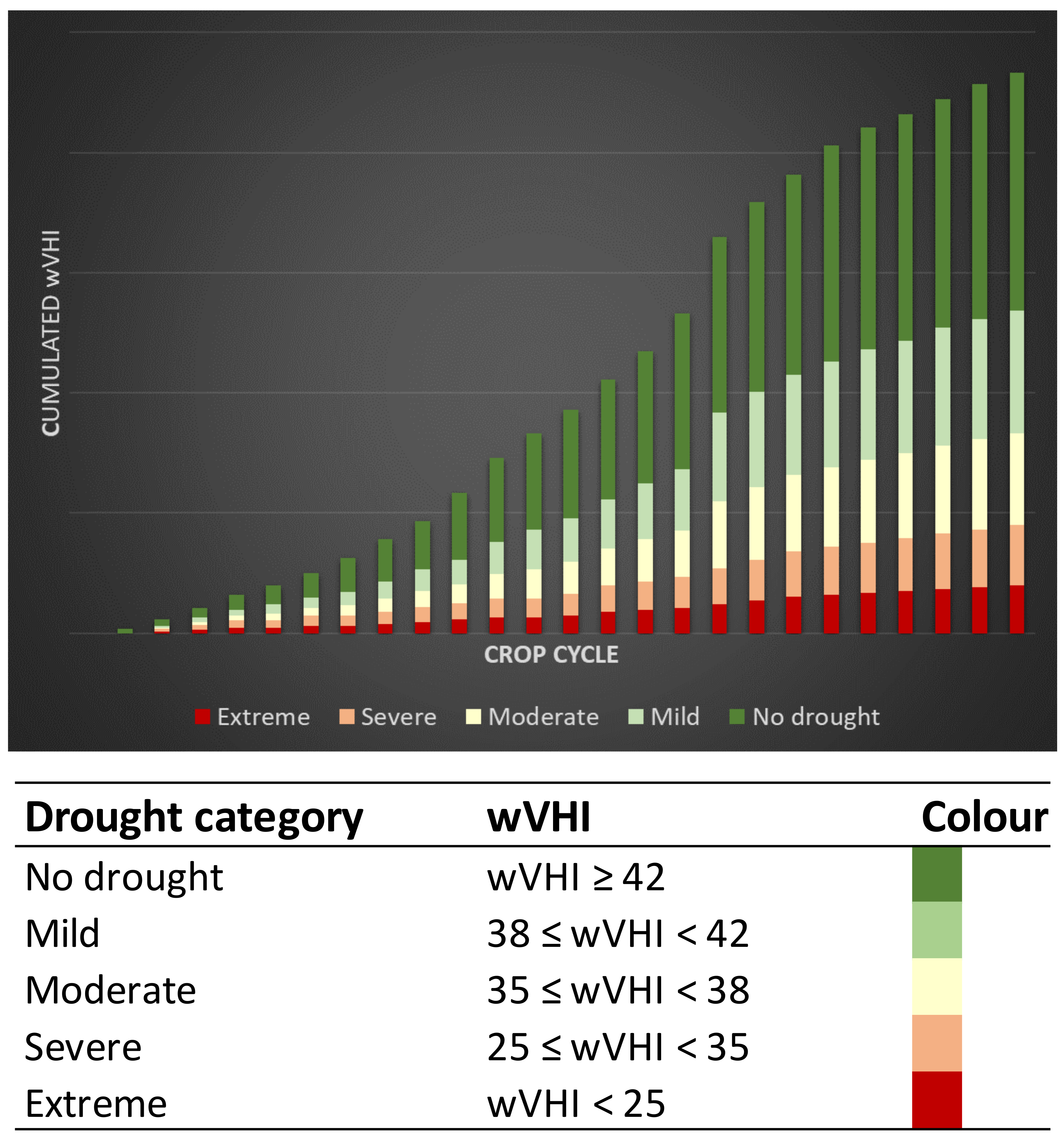


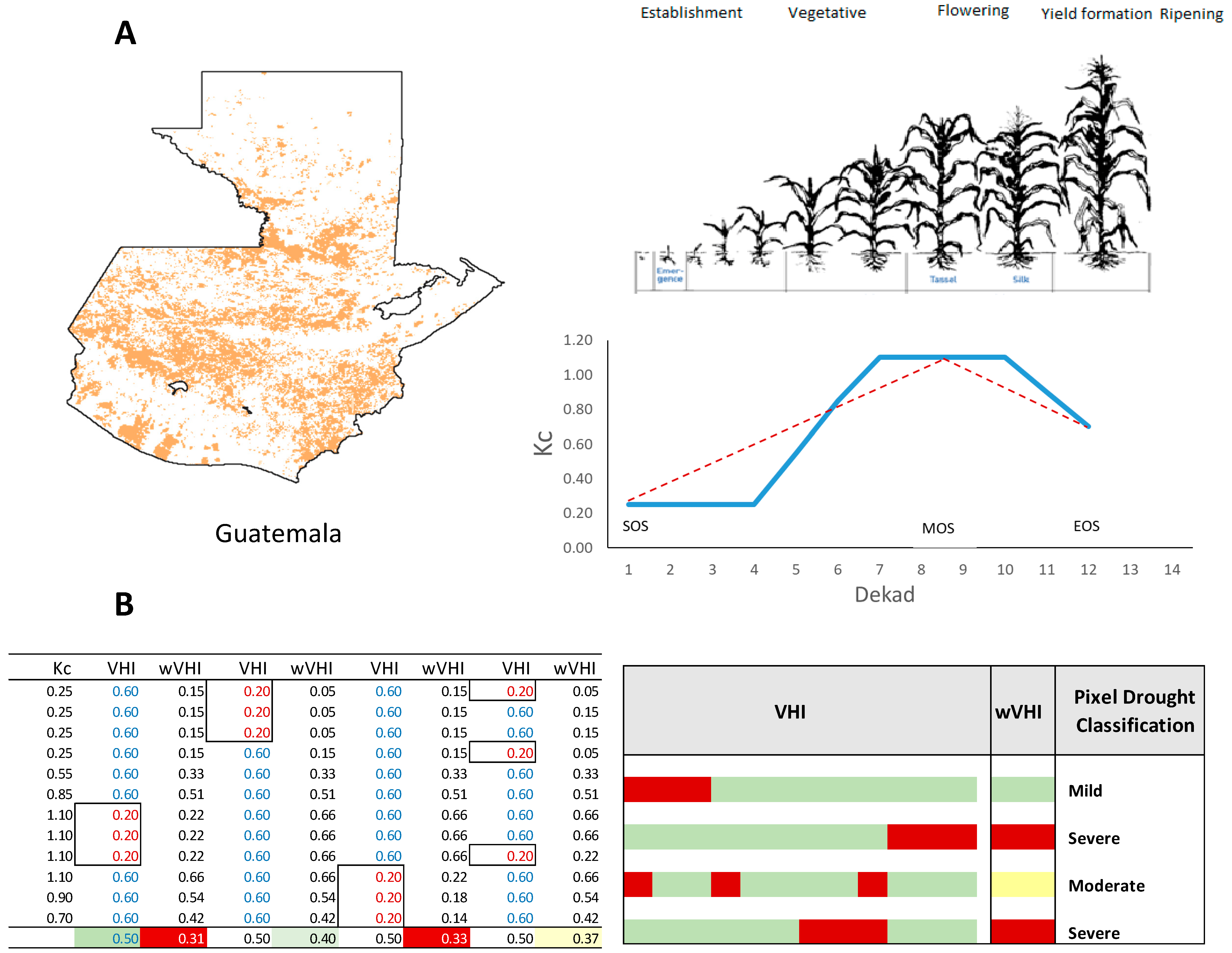
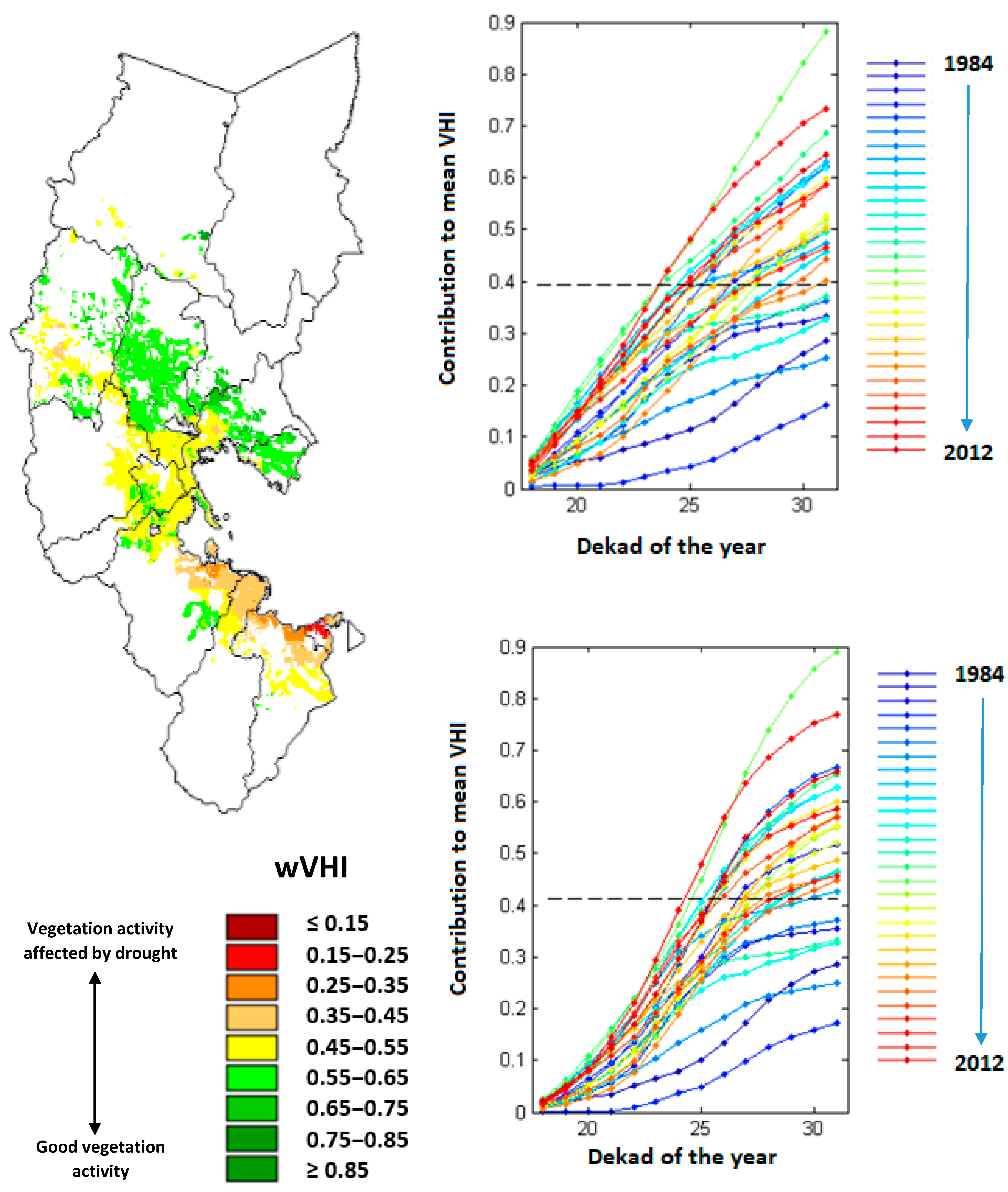


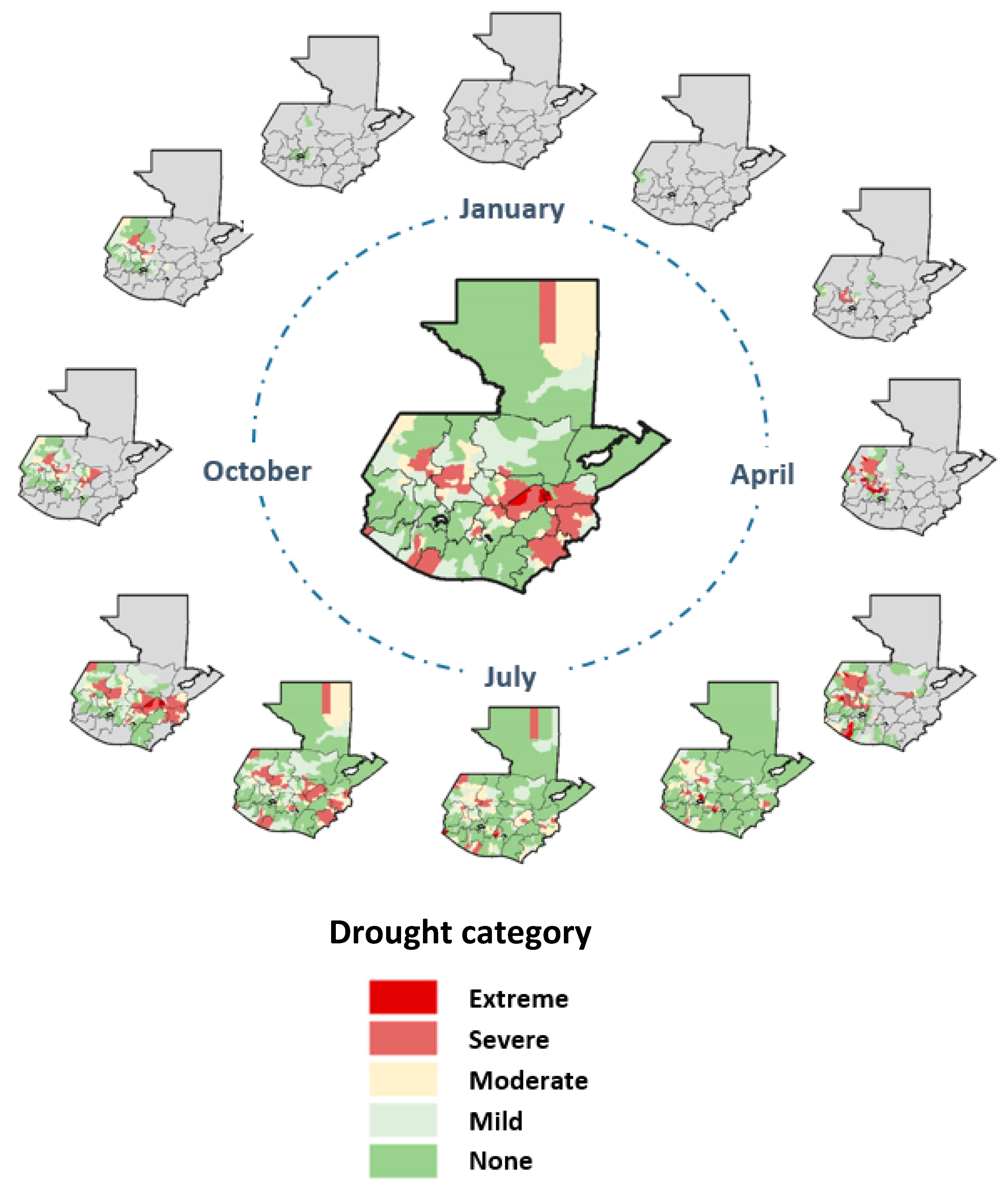

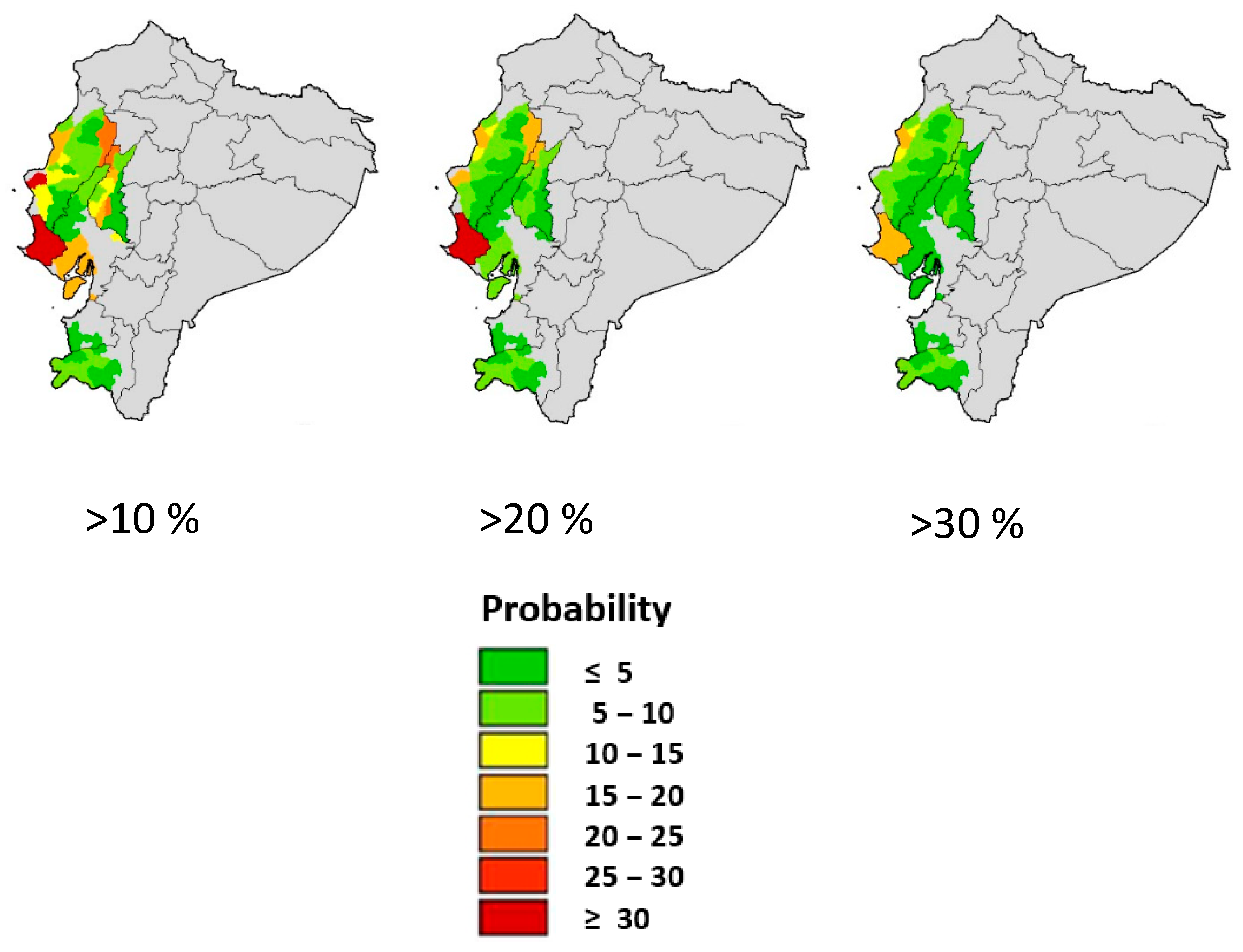
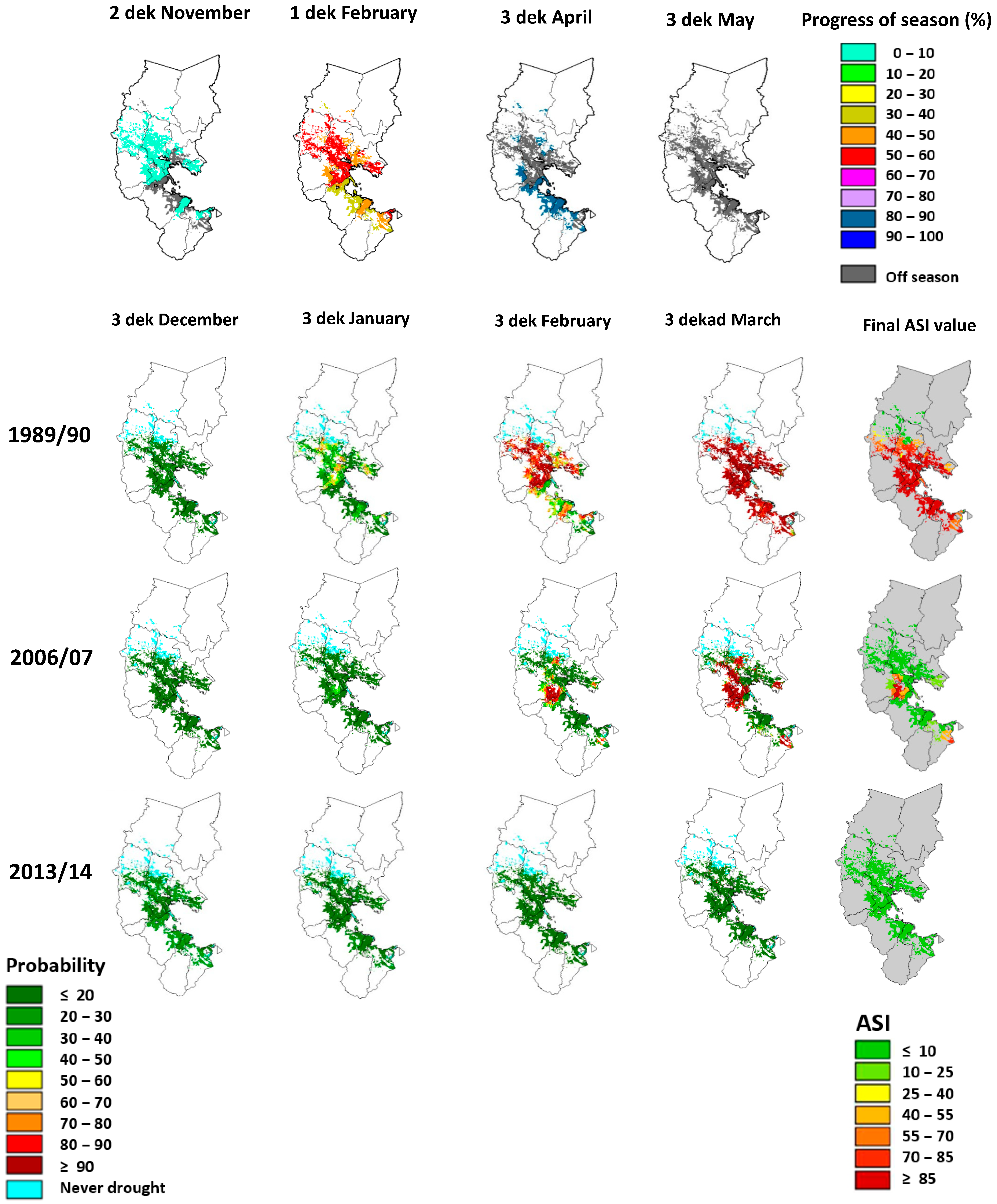
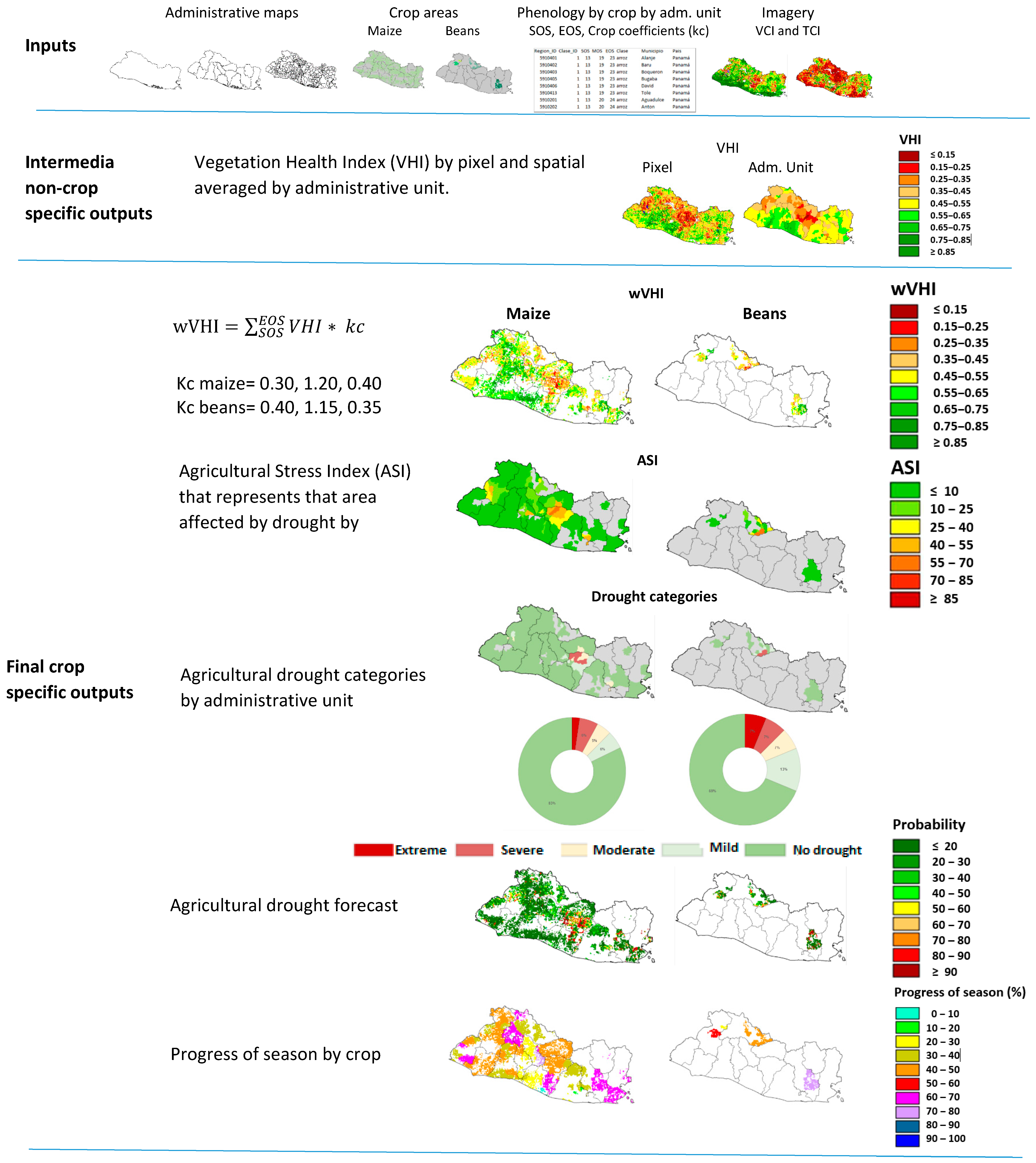

| Global ASIS | Country Level ASIS | Next Generation ASIS | |
|---|---|---|---|
| Purpose | Global ASIS was established in 2014 to support the Global Information and Early Warning System (GIEWS) to detect hot spots of agricultural drought around the world that could affect food security. It produces a collection of map dashboards both at global and country levels (196 countries). | Country level ASIS was launched in 2017 for strengthening the national drought monitoring systems in agriculture. | Next Generation ASIS launched in 2020 with the purpose of strengthening the national drought monitoring systems in agriculture and link the system to Early Action, Crop Insurance and Social Protection Schemes. |
| Crop mask | Global ASIS use a combined crop mask for cereals (maize, sorghum, rice, wheat, oat, millet, barley and teff) and grassland mask. Source: Global Land Cover-SHARE (GLC-SHARE) | Crop specific mask that allow to analyze independently maize from rice and so on. It is possible to introduce any crop including perennial crops such as sugar cane, coffee, grasslands, etc.). Source: most recent land use study available in the country. | Next Generation ASIS uses the most recent crop specific mask provided by the country. It is possible to introduce any crop including perennial crops such as sugar cane, coffee, grasslands, etc.). Source: most recent land use study available in the country. |
| Start of Season (SOS) and End of Season (EOS) | Global phenology maps comes from a model based on NDVI data, indicating the number of growing seasons and their start (SOS) and end dates (EOS), were derived from a multi-annual image set of SPOT-Vegetation (1999–2011). This approach allows the analysis of two crop seasons by year. | SOS and EOS come from the field by administrative unit. The dates are crop specific and refer to a common time that most of the famers use to plant and the length of the crop cycle used in each administrative unit. This approach allows the analysis of more than two crop seasons per year. | SOS and end EOS come from the field by an administrative unit. The dates are crop specific and refer to a common time that most of the famers use to plant and the length of the crop cycle used in each administrative unit. This approach allows the analysis of more than two crop seasons per year. |
| Vegetation Health Index (VHI) | The Vegetation Health Index (VHI) is calculated given equal weight to the Vegetation Condition Index (VCI) and Temperature Condition Index (TCI) (Kogan, 1997). | In the calculation of VHI the user can assign different weight to VCI and TCI. | In the calculation of VHI the user can assign different weight to VCI and TCI. |
| Weighted Vegetation Health Index (wVHI) | In the temporal integration of VHI from SOS and EOS, each VHI anomaly has equal weight. This approach did not discern between different crop demands of water consumption neither different sensitivity to water stress of the phenological phases during the crop cycle. | In the temporal integration of VHI, from SOS and EOS, each VHI anomaly is multiplied by a crop coefficient (kc). This approach introduces two important aspects to improve accuracy of the method. First, it would help to discern between different demands of water consumption by crop. Secondly, during the crop cycle, it provides more weight to VHI anomaly that occurs during sensitive phenological phases to water stress such as a flowering or grain filling, in the case of cereals. | In the temporal integration of VHI, from SOS and EOS, each VHI anomaly is multiplied by a crop coefficient (kc). This approach introduces two important aspects to improve accuracy of the method. First, it would help to discern between different demands of water consumption by crop. Secondly, during the crop cycle, it provides more weight to VHI anomaly that occurs during sensitive phenological phases to water stress such as a flowering or grain filling, in the case of cereals. |
| Agricultural drought forecast | Drought forecast is produced by Global ASIS for internal use. | Using the machine learning approach ASIS produces a drought forecast in the crop specific agricultural areas at the pixel level (Meroni, et al. 2014). The forecast is produced from the SOS up to EOS, every 10-day at 1 km spatial resolution. The accuracy of the forecast improves from 50% of the progress of crop cycle due to the reduction of uncertainties. The forecast express a theoretical probability of drought occurrence. | Using the machine learning approach ASIS produces a drought forecast in the crop specific agricultural areas at the pixel level (Meroni, et al. 2014). The forecast is produced from the SOS up to EOS every 10-day at 1 km spatial resolution. The accuracy of the forecast improves from 50% of the progress of crop cycle due to the reduction of the uncertainties. The forecast express the theoretical probability of drought occurrence. |
| Length of the imagery time series | ASIS uses a unique dataset of time series 30+, starting in 1984. As METOP became operational only in 2007, the series has been extended with similar AVHRR data from NOAA since 1984. In the current step, the 16 km resolution NOAA images were first resampled to the 1 km framing of METOP, using a simple inverse distance interpolation. However, as these upgraded 1 km NOAA scenes were somewhat blurry and lacking in spatial detail, their content was further enhanced using a data fusion method (Van Hoolst, R., 2016). The extension of 30+ years of remote sensing data is appropriate to study drought because the duration of natural cycle of rainfall is completed in approximately 30 years. Extreme drought is a rare climate event that occurrs once in 10 years. | Country level ASIS uses the full archive of VCI and TCI from global data for each specific area of interest (i.e., country). The user manually introduce in the toolbox to perform the analysis of remote sensing data every 10-day. | Next Generation ASIS used the full archive of VCI and TCI from global data for each specific area of interest (i.e., country). Using the ASIS Web application the calculation of the vegetation drought indices will be calculated and published on an automatic way. |
| Near real time (NRT) processing | From 2014 onwards, NRT processing was initiated at the premises of FAO and in a fully automated way. Besides providing the imagery archive (back to 1984) to Country ASIS users, every 10 days, Global ASIS processes the imagery used by Country ASIS and distribute them using the FAO-File Transfer Protocol (FTP). | At country level, ASIS is installed in a local computer including the images archive (1984–2020). Every 10-day the new images are receiving via FAO-FTP to keep operating the system in the countries. The local staff run the new information and produce the drought alerts. | Next Generation ASIS is installed on a Windows Server 2016 or superior (on the cloud or on premise). ASIS Web application will run on automatic way every time that new VCI and TCI images are available on the FAO-FTP. |
| Key outputs | Drought vegetation indices (VHI, VCI, TCI), ASI (% of agricultural area affected by drought) and Drought categories. Maps of drought vegetation indices are generated in automated way. Aggregated data at different administrative levels (Global Administrative Unit Layers (GAUL, levels 0, 1, 2) is also available. FAO using the new platform Hand in Hand distributing some global outputs of ASIS. | Drought vegetation indices (VHI, VCI, TCI), ASI (% of agricultural area affected by drought) and drought categories. ASIS produces simple graphs and maps of drought indices generated automatically to be used by the analyst. The maps and graphs are crop specific (maize, rice, sorghum, etc.) that have been calibrated using national land use maps and crop coefficients (kc). The user runs ASIS using a local computer and with the results they will prepare the alerts. | Drought vegetation indices (VHI, VCI, TCI), ASI (% of agricultural area affected by drought), Drought categories and other metrics derived from ASI such tonnes by hectare, number of people on food insecurity and monetary losses. Next Generation ASIS produces complex graphs that could combine ASI with socioeconomic variables that help the analyst to produce the alert. Maps and graphs are produced by the system in an automated way and outputs distributed through national website or geo-portals. The system allows to expand the information at subnational level. |
Publisher’s Note: MDPI stays neutral with regard to jurisdictional claims in published maps and institutional affiliations. |
© 2021 by the author. Licensee MDPI, Basel, Switzerland. This article is an open access article distributed under the terms and conditions of the Creative Commons Attribution (CC BY) license (http://creativecommons.org/licenses/by/4.0/).
Share and Cite
Rojas, O. Next Generation Agricultural Stress Index System (ASIS) for Agricultural Drought Monitoring. Remote Sens. 2021, 13, 959. https://doi.org/10.3390/rs13050959
Rojas O. Next Generation Agricultural Stress Index System (ASIS) for Agricultural Drought Monitoring. Remote Sensing. 2021; 13(5):959. https://doi.org/10.3390/rs13050959
Chicago/Turabian StyleRojas, Oscar. 2021. "Next Generation Agricultural Stress Index System (ASIS) for Agricultural Drought Monitoring" Remote Sensing 13, no. 5: 959. https://doi.org/10.3390/rs13050959




